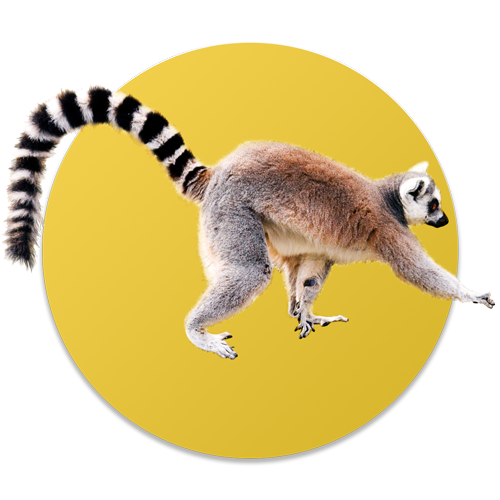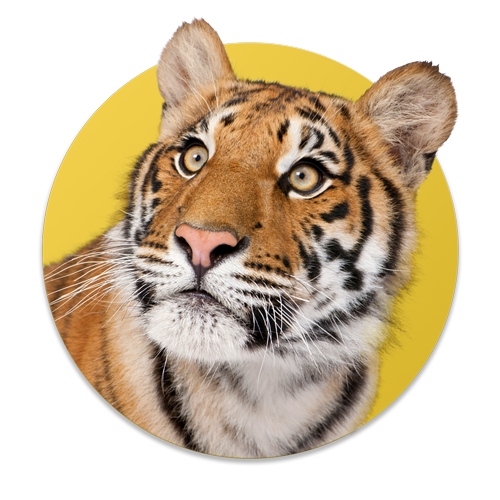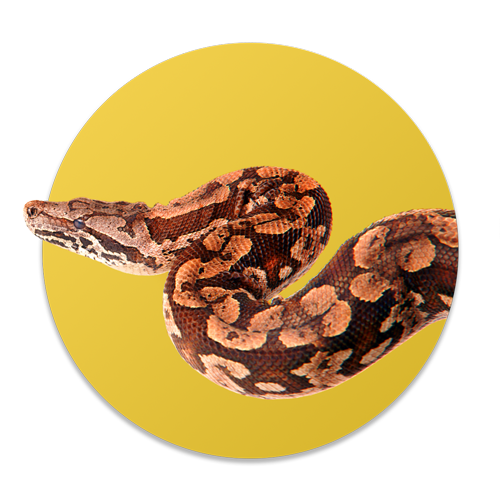Featured animals
Gondwana Park Zoo cares for 1,600 animals from over 146 species, some of which are endangered. The animals come from all corners of the globe. Check out some of our featured animals below.

Koala
About
The koala is a tree-dwelling marsupial that lives in coastal regions of Australia’s eastern and southern states: Queensland, NSW, Victoria and SA. Sometimes referred to as ‘koala bear’, the koala has distinct features with four legs, a silver or brown fluffy fur coat, round furry ears and a large black spoon-shaped nose. The koala has powerful, clawed hands and feet for climbing. They eat young eucalypt leaves from select species of eucalypt trees as they have developed a feature that allows them to digest the toxins in this type of plant. As such, they do not have much competition for food but both their habitat and food source are threatened by bushfires, land clearing and deforestation.
Interesting facts
The female koala carries her blind, hairless young in a pouch for the first seven months of its life where it feeds on its mother’s milk via teets in the pouch. By 18 months the young koala is independent and by three years of age it has reached sexual maturity. Koalas live to be about 12 years old in the wild. They are considered asocial creatures in that the only bonding between two koalas is between a mother and her young.
Statistics
Scientific name: Phascolarctos cinereus
Class: mammal
Order: diprotodontia
Status: vulnerable
Diet: herbivorous
Weight: 4 -15kg

Ring-tailed lemur
About
The ring-tailed lemur is a large primate native to the African island of Madagascar. It has a distinct, black and white long ringed tail and four legs, spending most of its time on the ground. Lemurs are herbivores that eat fruit, leaves and flowers.
Interesting facts
The ring-tailed lemur is highly social, living in groups of up to 30 lemurs known as troops. Females are dominant which is a trait common to the lemur population. Lemurs often huddle together to stay warm but also to reaffirm social bonds. They may sometimes be seen sunbaking with their white bellies exposed to the sun. Lemurs are highly vocal and use a number of calls as individuals or in a group to express themselves.
Statistics
Scientific name: Lemur catta
Class: mammal
Order: primate
Status: endangered (population decreasing)
Diet: herbivorous
Weight: 2.2kg (adult)

Bengal tiger
About
The Bengal tiger is the most common of the tiger family and the national animal of India and Bangladesh. The Bengal tiger was classified endangered in 2010 when there were found to be less than 2500 tigers remaining in the wild. They currently number about half of all tigers known to be living in the wild and may still be found in India and parts of Bangladesh. The Bengal tiger has a distinctive orange and brown/black striped upper coat and tail with white markings on the face and belly.
Interesting facts
Tigers are the largest cat species, with average adult male Bengals weighing up to 258kg and measuring up to 310cm (excluding tail). By comparison, an average male African lion weighs up to 189kg.
Bengal tigers live alone and scent-mark their territory to keep enemies away. They are aggressive nocturnal hunters that travel long distances to hunt their prey of deer, wild boar and water buffalo.
Female Bengals give birth to up to six tiger cubs, which they then raise alone. Cubs remain with their mothers for the first three years or so until they can competently hunt on their own.
Statistics
Scientific name: Panthera tigris tigris
Class: mammal
Order: carnivore
Status: endangered (population decreasing)
Diet: carnivorous
Weight: 90 – 310kg (male); 65 – 170kg (female)

Hippopotamus
About
The hippopotamus or hippo is a large, herbivorous mammal native to Africa. Hippos are the third largest land mammals after elephants and rhinoceroses. Hippos are semi-aquatic: they live in rivers, lakes and mangrove swamps where the male hippos or bulls aggressively rule over a large stretch of space that homes between up to 30 female hippos and their young. The hippo is recognisable by its wide opening mouth and barrel-shaped, hairless body. They can run up to 30km per hour.
Interesting facts
In ancient Greek ‘hippopotamus’ means ‘river horse’. While hippos may look cute, they are considered the most dangerous animal in Africa because they are highly aggressive. Yet the hippo’s aggression is limited to water; they do not tend to be territorial on land. They eat up to 40kg grass a night and maintain a sedentary lifestyle by day wallowing in the water or mud and digesting their food. Both reproduction and childbirth happen in the water or mud.
Statistics
Scientific name: Hippopotamus amphibious
Class: mammal
Order: artiodactyla
Status: vulnerable
Diet: herbivorous
Weight: 1500kg (male); 1300kg (female)

Meerkat
About
Meerkats are small, carnivorous animals belonging to the mongoose family. They live in desert areas of Botswana, Namibia, Angola and South Africa. The meerkat uses its long tail to balance when standing upright on its back legs, as well as for signalling. Their facial shape is similar to that of a dog in that it tapers to a point. Meerkats have black circular markings around their eyes, which help lessen the dessert glare and black, round ears. Their coats are usually peppered grey, tan, or brown and silver and they have parallel stripes across their backs.
Interesting facts
A group of around 20 meerkats is called a ‘mob’. Bigger families result in mobs of up to 50 meerkats. Meerkats eat insects, lizards, snakes, scorpions, spiders, eggs, small mammals such as mice, plants and fungi. Meerkats are immune to some venomous animals, particularly scorpions. They forage for food in a group while one meerkat stands guard for predators or threats. They can move their weight in sand in just seconds using their powerful claws to dig. Meerkats live to about 12 years old when they are in captivity and about half this age when they’re in the wild.
Statistics
Scientific name: Suricata suricatta
Class: mammal
Order: carnivore
Status: least concern
Diet: carnivorous
Weight: 600g – 2.5kg

Boa constrictor
About
Boa constrictors are non-poisonous snakes found in tropical Central and South America. They are related to the anaconda but significantly smaller, growing up to 4m long and weighing around 27kg. Large female boa constrictors have been known to weigh up to 45kg. Boa constrictors have very distinctive camouflage markings that vary according to their surroundings: they may be green, red, tan or yellow and display stripes, ovals, diamonds and circles. Unlike their anaconda relatives, boa constrictors do not favour water but live in deserts, tropical forests and open plains.
Interesting facts
Boa constrictors mainly eat small animals such as bats, mice, birds, possums and lizards but have been known to eat wild pigs and monkeys. They use their powerful jaws and teeth to grab onto prey while their body constricts around it and suffocates it. They are then able to extend their jaws wide enough to swallow prey whole. Female boas incubate and hatch their eggs internally and give birth to up to 60 live babies, each of which is around 60cm long.
Statistics
Scientific name: Boa constrictor
Class: reptile
Order: squamata
Status: not currently threatened but may become so unless trade in specimens is subject to strict regulation.
Diet: carnivorous
Weight: up to 27kg

Red panda
About
Red pandas are native to south-western China and the eastern Himalayas. Red pandas are slightly bigger than a domestic cat, with reddish brown fur, a striped fluffy tail and short legs. They have distinct white ‘panda’ markings around their eyes, ears and nose. They mainly live in trees and their diet is two-thirds bamboo, but they also eat mushrooms and lichen, eggs, birds, fish and insects.
Interesting facts
Red pandas are active from dusk until dawn but lead quite sedentary lives due to their low calorie diet of primarily bamboo. They tend to be territorial, solitary animals except for mating season each summer. They usually mate with a single partner at around 18 months of age, with females giving birth to up to four deaf and blind cubs who stay with her until the next litter is born the following summer.
With only 10,000 red pandas living in the wild, they are listed as an endangered species. Despite being protected by national laws in their native countries, red pandas are threatened by human poachers, habitat loss and fragmentation and inbreeding.
Statistics
Scientific name: Ailurus fulgens
Class: mammal
Order: carnivore
Status: endangered
Diet: omnivorous
Weight: up to 6kg

Giraffe
About
The giraffe is an even-toed ungulate (hoofed) mammal, meaning its weight is borne evenly by the third and fourth toes. Giraffes are the tallest of all animals, growing up to 5.5m tall and weighing over a tonne. Giraffes strike a very distinct figure with their long neck, long legs and spotted coats. They also have long tongues that are purple to protect against the desert sun. Giraffes inhabit scattered territory from the Republic of Chad in the north to South Africa in the south, from Niger in the west to Somalia in the east. They generally live in open savannahs, grasslands and woodlands and feed on acacia leaves that grow out of reach of most other animals.
Interesting facts
Giraffes are social animals usually found in sex-segregated groups of up to 44 individuals. Groups regularly associate with one another in larger communities. Female giraffes are pregnant for between 400-460 days and give birth to a single calf, although occasionally they may have twins. Within a few hours of being born the calf can run around. The amount of time a calf may stay with its mother is variable but can last until the next calving.
Statistics
Scientific name: Giraffa Camelopardalis
Class: mammal
Order: artiodactyla
Status: least concern
Diet: herbivorous
Weight: 1100-1900kg (males), 700-1100kg (females)
